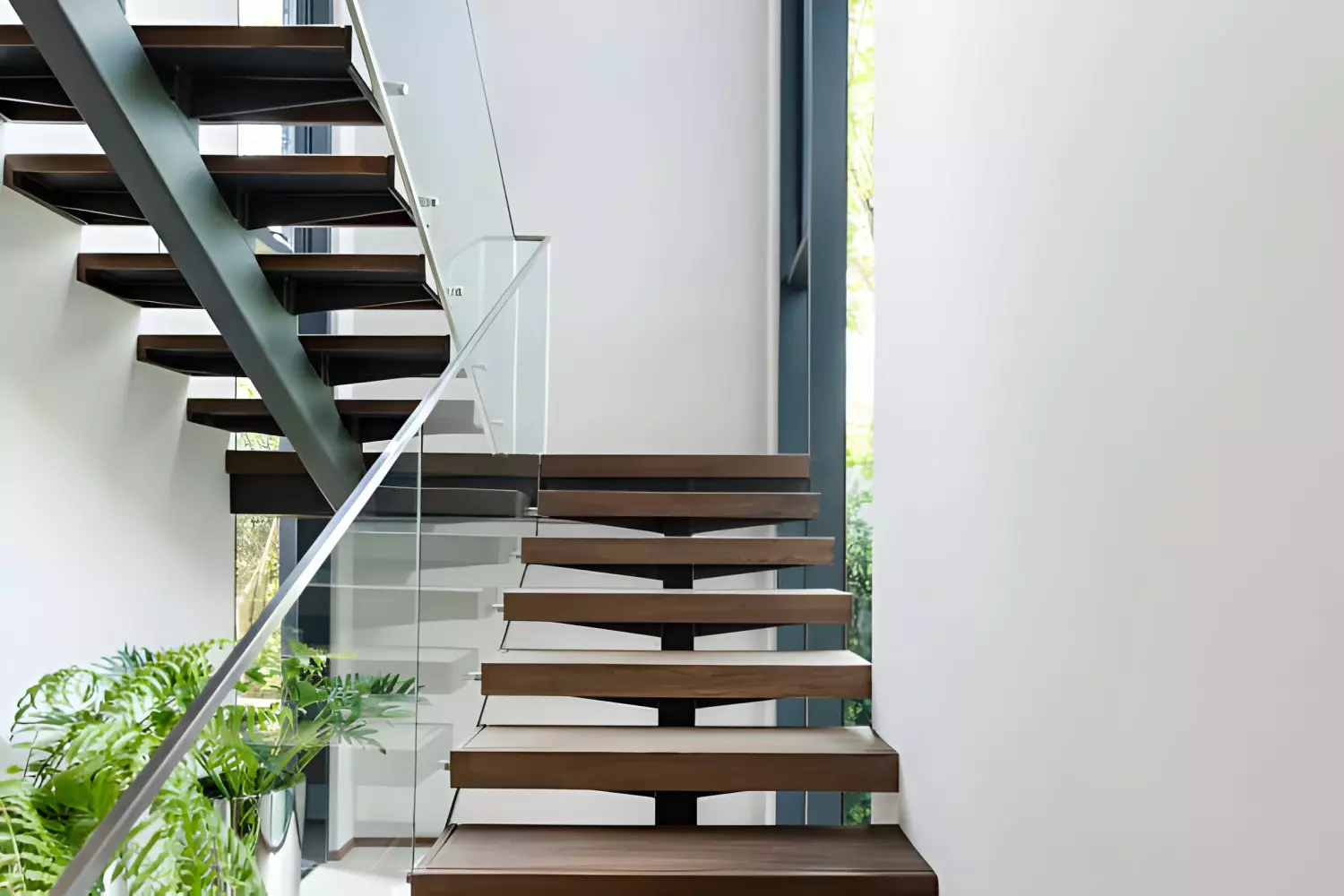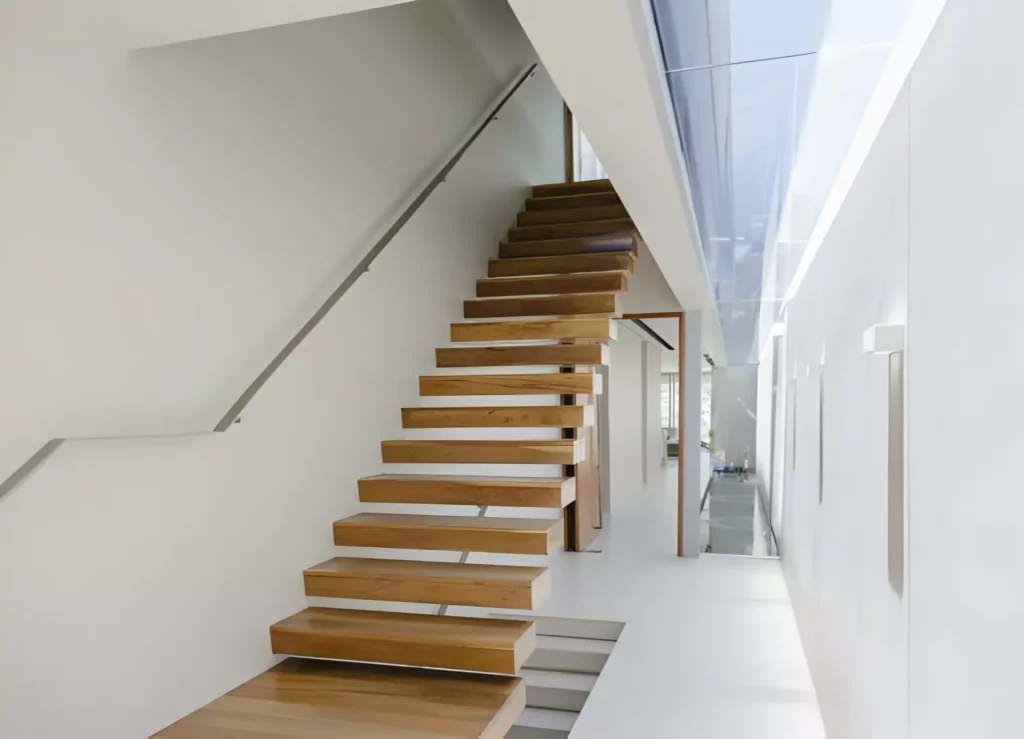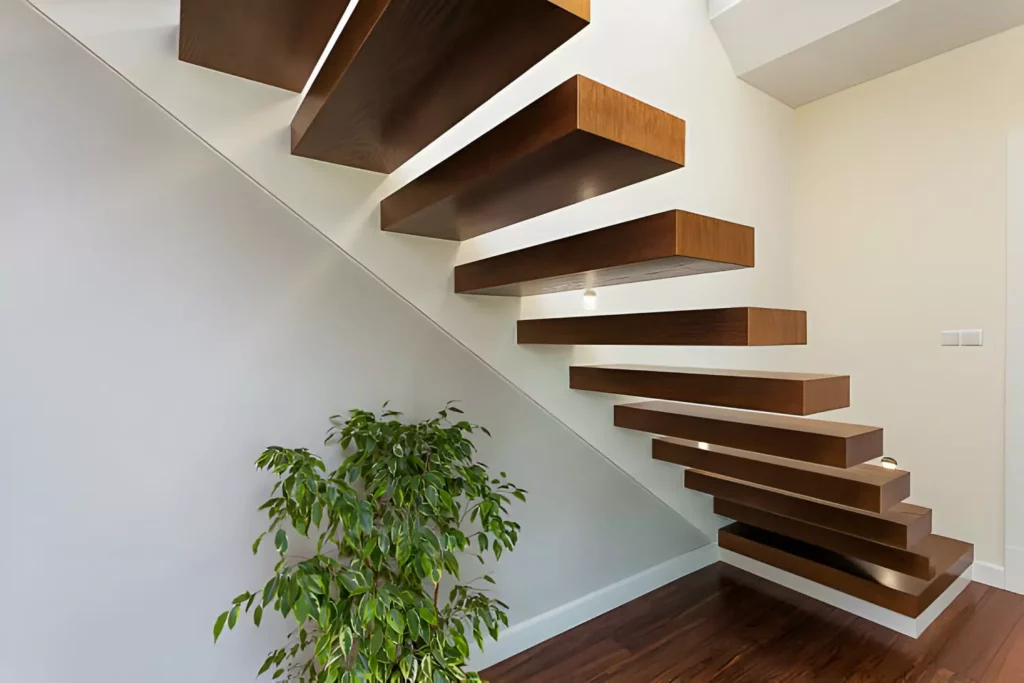
What are floating stairs
Floating stairs are a modern architectural decision that seems to defy gravity. Their minimalist design creates a visual illusion. These innovative stairs elevate the aesthetics of any space they are applied to. But apart from these, what else do we know? Let’s talk about it all in more detail.
How Floating Stairs Are Installed
Installing floating stairs requires precision and expertise. Firstly, a sturdy structural support system must be created within the wall or attached to a support beam to bear the weight of the stairs. Then, measurements are important to ensure the proper placement of the steps, which typically lack risers, giving them the appearance of “floating.” Next, specialized brackets or anchors are fixed to the wall or structural support, providing the base for each step.
These brackets are carefully aligned to securely hold the steps in place while maintaining the illusion of floating. Finally, the steps, often made of materials like wood, glass, or metal, are affixed to the brackets, ensuring they are level and stable. Professional installation by experienced craftsmen is important to guarantee safety and structural integrity.
Most popular types of floating stairs
Did you know that there are many types of floating stairs? It may seem that floating stairs are floating stairs and that’s it…but that’s not the case! Let’s talk about some of the most popular types of floating stairs you may use to elevate your property.
Mono Stringer Staircases

Mono stringer floating stairs feature a single, central support beam (that’s why it’s called mono stringer), often positioned beneath the steps, creating a clean, open look. This design eliminates the need for multiple stringers, making a more minimalistic appearance. The single stringer provides structural support while showcasing a modern appearance. It’s a popular choice in contemporary architecture for its sleek look.
Cantilever Staircases
 Cantilever floating stairs construction involves steps that seem to float without visible supports, thanks to their unique design. These stairs are anchored only on one side, utilizing a strong beam or support structure to extend outward, creating a modern look effect. The absence of visible support on one side gives the impression of steps hovering in mid-air. Cantilever staircases offer a unique mix of mind-blowing architectural decisions and functionality, often found in both futuristic and contemporary interior designs.
Cantilever floating stairs construction involves steps that seem to float without visible supports, thanks to their unique design. These stairs are anchored only on one side, utilizing a strong beam or support structure to extend outward, creating a modern look effect. The absence of visible support on one side gives the impression of steps hovering in mid-air. Cantilever staircases offer a unique mix of mind-blowing architectural decisions and functionality, often found in both futuristic and contemporary interior designs.
Straight Staircases

Straight floating staircases combine the simplicity of a straight staircase with the modern charm of floating steps. These stairs lack visible support underneath. They typically use hidden structural support within the wall or beneath each step, giving the impression of steps floating in mid-air. Straight floating staircases are loved by many because they can blend into almost any modern interior design.
Spiral Staircases

Floating spiral stairs can enhance the perception of an entire room. They often have a hidden structural support system within the center column or beneath each step, giving the illusion of steps floating in the air. This design offers a space-saving solution. Floating spiral stairs are popular for their striking appearance, making them a stylish choice for contemporary and eclectic spaces seeking a mix of innovation and design, while also saving some space.
How are Floating Stairs Supported?
Floating stairs achieve their illusion of weightlessness through hidden structural support. Various methods are used to support these stairs without visible attachments. One common approach involves using steel brackets or anchors that are securely attached to the wall or a supporting structure, such as a beam or stringer. These brackets are then concealed within the steps, providing stability and bearing the weight of each tread.
In some designs, a single central stringer or column supports the stairs. Some stairs use a cantilevered structure, anchoring the steps on one side while leaving the other side open, contributing to the floating effect. The steps themselves may be made from materials like wood, glass, or metal, adding to the aesthetic appeal while the hidden support mechanisms maintain the illusion of a floating staircase. Professional installation is important for structural integrity and safety.
The Pros and Cons of having Floating Stairs?
Let’s talk about pros and cons of floating stairs, to help you make more informative decision.
Pros:
- Aesthetic Appeal. Floating stairs offer a modern look that adds visual interest to any space.
- Space Optimization. They create a sense of openness, allowing light to flow through and making the area feel more spacious.
- Design Versatility. Available in various materials and styles, offering flexibility to suit different interior designs.
- Architectural Point of Interest. They serve as a point of interest, enhancing the overall aesthetic of any room.
- Customization. Allows for customization in terms of step materials, sizes, and configurations.
Cons:
- Complex Installation. Installation requires expertise and precision to ensure structural stability and safety. Hiring professionals is highly advisable.
- Potential Cost. Can be more expensive than traditional stairs due to specialized design and installation.
- Limited Handrail Options. Some designs might limit handrail options, impacting safety.
- Maintenance Challenges. Cleaning and maintenance can be trickier due to the open design.
- Foot Traffic Noise. Depending on the materials used, floating stairs may produce more noise while in use compared to traditional stairs.
So should you use such stairs for your property? There is no “right” or “wrong” answer here. You should weigh all the pros and cons and decide what outweighs what.

Choose Luxury Staircase Railings to Build Your Floating Stairs
When choosing floating staircases, selecting the right staircase railings is crucial. Our expertise lies in crafting railings that perfectly complement floating stairs. We have a long list of luxurious materials, from sleek metals to exquisite woods and innovative glass, ensuring a perfect match for any design aesthetic. Note that every chosen material hasn’t been chosen randomly. We use only high-quality and sturdy materials.
What sets Luxury Staircase Railings apart is our commitment to precision and customization. We prioritize personalized designs for every client, making railings to fit the specific dimensions and style preferences of each project. Our attention to detail always guarantees safety and construction durability.

